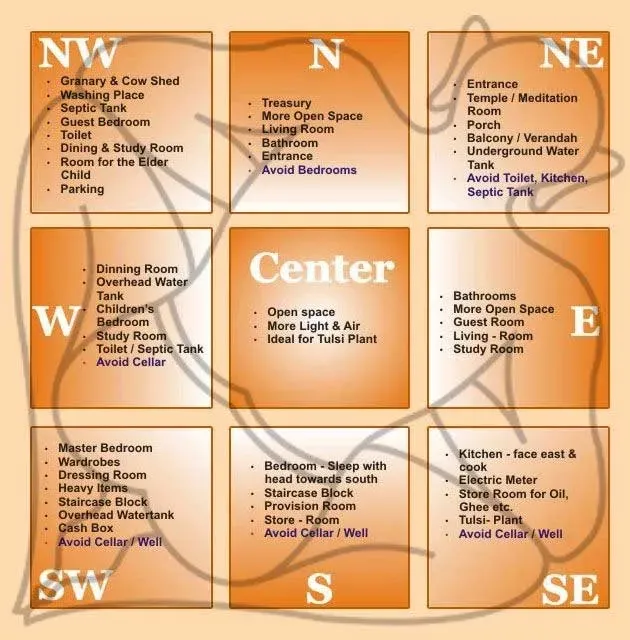Have you ever walked into a room and instantly felt a sense of calm, while another space leaves you feeling drained? This feeling might not be a coincidence. Vastu Shastra, an ancient Indian system of architecture and design, emphasizes the harmonious connection between humans and their environment.
More Than Just Decoration
Vastu Shastra goes beyond mere aesthetics. It's a holistic approach to design that considers the natural elements – earth, air, fire, water, and space – and their influence on our well-being. By following Vastu principles, you can create a living space that promotes positive energy flow, fosters good health, and supports your overall well-being.
The Guiding Principles of Vastu
Vastu incorporates several key principles to create a balanced and harmonious environment:
- Directional Placement: Vastu assigns specific functions to different directions. For example, the northeast corner is considered ideal for the pooja room, while the southwest corner is best suited for the master bedroom.
- Energy Flow: The concept of "prana," or life force energy, is central to Vastu. The layout of your home should facilitate the smooth flow of positive energy throughout the space.
- Natural Elements: Vastu emphasizes incorporating the five elements – earth, air, fire, water, and space – into your design. This can be achieved through natural light, proper ventilation, the use of natural materials, and even water features.
- Symmetry and Order: Creating a sense of visual balance is important in Vastu. This can be achieved through symmetrical layouts, proper placement of furniture, and avoiding clutter.
Benefits of Vastu
While Vastu is not a rigid set of rules, incorporating its principles can offer several potential benefits:
- Improved well-being: A balanced and harmonious living space can promote feelings of peace, relaxation, and overall well-being.
- Enhanced energy levels: Proper energy flow as per Vastu principles may contribute to increased energy levels and a more positive outlook.
- Better sleep: A calm and balanced environment can contribute to better sleep quality.
- Greater productivity: Creating a designated workspace that promotes focus and concentration can lead to increased productivity.
Getting Started with Vastu
If you're interested in exploring Vastu for your home, here are some steps you can take:
- Do your research: There are many resources available online and in libraries that can provide you with a basic understanding of Vastu principles.
- Consult a Vastu expert: A qualified Vastu consultant can assess your space and recommend specific adjustments to align it with Vastu principles.
- Start small: You don't have to overhaul your entire home overnight. Start by making small changes, such as rearranging furniture or decluttering specific areas.
Vastu Shastra offers a roadmap for crafting a balanced living space, but putting those principles into action can feel overwhelming. Here's a practical guide to incorporating Vastu into different areas of your home:
The Entrance:
- The main door, considered the "mouth" of your home, ideally faces north or east to encourage positive energy flow.
- Keep the entrance well-lit and free of clutter.
- A welcoming doormat and a functional doorbell are seen as auspicious.
The Living Room:
- This is the heart of your home, so create a space that promotes connection and relaxation.
- Position your seating area in the south or west direction.
- Minimize clutter and ensure ample natural light.
- Consider calming colors like blue or green and artwork with positive scenes.
The Kitchen:
- The kitchen represents fire and transformation. Ideally, locate it in the southeast corner.
- The stove should face east for positive energy while cooking.
- Store water in the north or northeast corner, away from the stove's heat.
- Opt for bright and warm colors like yellow or orange to encourage energy and creativity.
The Bedroom:
- The bedroom is a space for rest and rejuvenation. The southwest corner is considered ideal for the master bedroom.
- Position the bed with the headboard against a wall, preferably south or west.
- Avoid electronics near the bed as they can disrupt sleep.
- Opt for calming colors like blue, green, or lavender to promote restful sleep.
Declutter and Clean:
- Clutter is seen as stagnating energy flow according to Vastu. Regularly declutter your home to maintain a sense of order and spaciousness.
- Maintaining cleanliness is another key principle. Regularly clean your home to remove negativity and create a fresh, inviting atmosphere.
Remember:
- Vastu is a guide, not a set of rigid rules. Adapt the principles to your existing space and preferences.
- Start small and gradually incorporate Vastu elements into your home. Don't feel pressured for drastic changes.
- Ultimately, trust your intuition. If a Vastu recommendation doesn't resonate with your space, adjust it accordingly.
By following these tips and experimenting with Vastu principles, you can create a balanced and supportive environment in your home. This, in turn, can contribute to your overall well-being and happiness.











